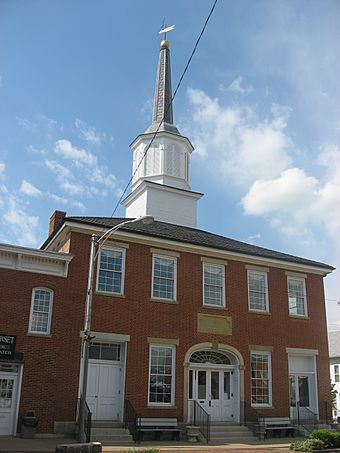Old Perry County Courthouse (Ohio) facts for kids
Quick facts for kids |
|
|
Old Perry County Courthouse
|
|
|
U.S. Historic district
Contributing property |
|

Front of the courthouse
|
|
| Location | Main and Columbus Streets, Somerset, Ohio |
|---|---|
| Built | 1829 |
| Architectural style | Federal |
| Part of | Somerset Historic District (ID75001516) |
| Added to NRHP | September 5, 1975 |
The Old Perry County Courthouse is an old government building in Somerset, Ohio, United States. It was built in the 1820s to be a courthouse. This building is one of Ohio's oldest courthouses still standing. It was even part of a big argument about where the county's main office should be. For a long time, it has served as Somerset's village hall. The building is located in a special historic area.
Contents
History of the Courthouse
The village of Somerset was started in 1810. Settlers from Somerset, Pennsylvania founded it. It was located on Zane's Trace, a famous old road. Seven years later, in 1817, parts of three other counties were joined. This created Perry County, Ohio. A house in Somerset was used as the first temporary courthouse.
In 1819, the county government built a new place in Somerset. Most of this building was a jail. But it also had a courtroom and some offices for the county. Ten years later, in 1829, the building you see today was built. It was on the village's public square. However, officials soon found it was too small. Some offices stayed in the old jail until a new jail was built next to the courthouse in 1848.
The County Seat Dispute
Over time, the village of New Lexington grew larger. Its residents wanted the county's main office, or "county seat," to move there. From 1851 to 1859, the state government passed three laws. These laws allowed the county seat to move.
There were many arguments and elections. The Supreme Court of Ohio even made a decision. The county seat moved to New Lexington, then back to Somerset, and finally back to New Lexington. After this, the Old Perry County Courthouse was no longer used as a courthouse. Instead, it was rented to Somerset to be its village hall. The building has lasted longer than the first courthouse in New Lexington. That building became too small and was replaced in 1888.
Building Design
The Old Perry County Courthouse is a two-story building. It is made of brick and has a stone foundation. It cost about $6,600 to build. The building was first about 45 feet long and 42 feet wide. It was changed when the jail was built next to it.
A small dome, called a cupola, sits on top of the building. The front of the building has five sections, or bays. We do not know the names of the people who designed or built it. The main front door was still there in the 1950s. The other two doors on the front were changed. They were used to get straight to the second floor. This floor had spaces for a group called the American Legion, a library, and a barbershop.
The roof is a hip roof, meaning it slopes on all four sides. It probably had slate tiles when it was built. Wooden decorations are on the edges of the roof. Inside, none of the original room layout remains. The building is on the corner of Main and Columbus Streets. It faces the public square.
Special Inscription
One special part of the courthouse is a message carved into the stone above the main entrance. It says: "Let Justice be done. If the Heavens should fall". This unusual phrase has gotten a lot of attention. People have wondered what it means and where it came from.
A story says the phrase was supposed to be "Let Justice be done though the Heavens fall". But the stonemason, the person who carved it, ran out of space for the longer word "though."
In his book, Historical Collections of Ohio, Henry Howe wrote a lot about this phrase. He said it was the main thing a former Somerset resident remembered about the building. Another writer in 1901 called the phrase "wonderful" but noted its strange wording.
Some people thought the inscription was a grammar mistake. One legend says a German man, who felt he was treated unfairly in a lawsuit, suggested the phrase. He insisted the judge, who oversaw his case, take credit for it. When the mistake was noticed a year later, the judge was criticized so much that he had to move out of state. Other people have seen the phrase more kindly. They called it a "quaint, old Irish bull" or just the idea of a well-meaning pioneer who was not good with words.
Saving the Building
The Old Perry County Courthouse is a good example of early courthouses in Ohio. It is also the oldest government building in the former Northwest Territory that has been used continuously. Because of this, it received money from the state for restoration.
In 1975, much of Somerset was named a historic district. This was called the Somerset Historic District. The courthouse was a very important building within this district. It was then listed on the National Register of Historic Places. This courthouse is one of only two first-generation Federal courthouses still standing in Ohio. The other is the Old Meigs County Courthouse in Chester.




